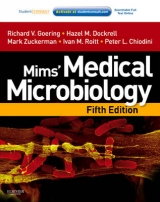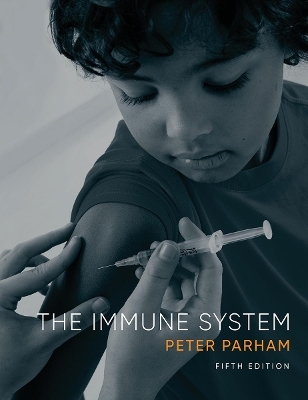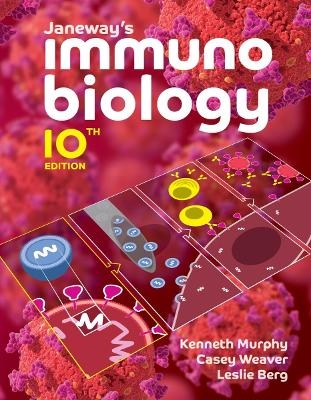
Mims' Medical Microbiology
Mosby
978-0-323-04475-2 (ISBN)
- Titel erscheint in neuer Auflage
- Artikel merken
"Mims Medical Microbiology" offers you thorough and up-to-date coverage of microbiology and basic immunology, through a clinically relevant, systems-based approach. It emphasises the microbiology of the agents causing disease, and the diseases affecting individual organ systems. Through thorough cross referencing, you can easily find what you need, whether seeking information from a systems or a microbe perspective. Nearly 500 illustrations help you to visualise the subject!
1. Microbes as parasites .The varieties of microbes .Living inside or outside cells .Systems of classification 2. The bacteria .Structure .Nutrition .Growth and division .Gene expression .Extrachromosomal elements .Mutation and gene transfer .Survival under adverse conditions .The genomics of medically important bacteria 3. The viruses .Infection of host cells .Replication .Outcome of viral infection .Major groups of viruses 4. The fungi .Major groups of disease-causing fungi 5. The protozoa 6. The helminths and arthropods .The helminths .The arthropods 7. Prions .'Rogue protein' pathogenesis .Development and transmission of prion diseases .Medical problems posed by prion disease 8. The host-parasite relationship .The normal flora .Symbiotic associations .The characteristics of parasitism .The evolution of parasitism 9. The innate defenses of the body .Defense against entry into the body .Defenses once the microorganism penetrates the body 10.Adaptive responses provide a 'quantum leap' in effective defense .The role of antibodies .The role of T lymphocytes .Extracellular attack on large infectious agents .Local defenses at mucosal surfaces 11. The cellular basis of adaptive immune responses .B and T cell receptors .Clonal expansion of lymphocytes .The role of memory cells .Stimulation of lymphocytes .Cytokines .Regulatory mechanisms .Tolerance mechanisms 12. Background to the infectious diseases .Host-parasite relationships .Causes of infectious diseases .The biologic response gradient 13. Entry, exit and transmission .Sites of entry .Exit and transmission .Types of transmission between humans .Transmission from animals 14. Immune defenses in action .Complement .Acute phase proteins and pattern recognition receptors .Fever .Natural killer cells .Phagocytosis .Cytokines .Antibody-mediated immunity .Cell-medited immunity .Recovery from infection 15. Spread and replication .Features of surface and systemic infections .Mechanisms of spread through the body .Genetic determinants of spread and replication .Other factors affecting spread and replication 16. Parasite survival strategies and persistent infections .Parasite survival strategies .Concealment of antigens .Antigenic variation .Immunosuppression .Persistent infections 17. Pathologic consequences of infection .Pathology caused directly by the microorganism .Pathologic activation of natural immune mechanisms .Pathologic consequences of the immune response .Skin rashes .Viruses and cancer Introduction to Section 4: The Clinical Manifestations of Infection 18. Upper respiratory tract infections .The common cold .Pharyngitis and tonsillitis .Parotitis .Otitis and sinusitis .Acute epiglottitis .Oral cavity infections .Laryngitis and tracheitis .Diphtheria 19. Lower respiratory tract infections .Acute infections .Chronic infections .Parasitic infections 20. Urinary tract infections .Acquisition and etiology .Pathogenesis .Clinical features and complications .Laboratory diagnosis .Treatment .Prevention 21. Sexually transmitted diseases .STDs and sexual behavior .Syphilis .Gonorrhea .Chlamydial infection .Other causes of inguinal lymphadenopathy .Mycoplasmas and non-gonococcal urethritis .Other causes of vaginitis and urethritis .Genital herpes .Human papillomavirus infection .Human immunodeficiency virus .Opportunistic STDs .Arthropod infestations 22. Gastrointestinal tract infections .Diarrheal diseases caused by bacterial or viral infection .Food poisoning .Helicobacter pylori and gastric ulcer disease .Parasites and the gastrointestinal tract .Systemic infection initiated in the gastrointestinal tract 23. Obstetric and perinatal infections .Infections occurring in pregnancy .Congenital infections .Infections occurring around the time of birth 24. Central nervous system infections .Invasion of the central nervous system .The body's response to invasion .Meningitis .Encephalitis .Neurologic diseases of possible viral etiology .Spongiform encephalopathy caused by scrapie-type agents .CNS disease caused by parasites .Brain abscesses .Tetanus and botulism 25. Infections of the eye .Conjunctivitis .Infection of the deeper layers of the eye 26. Infections of the skin, soft tissue, muscle and associated systems .Bacterial infections of skin, soft tissue and muscle .Mycobacterial diseases of the skin .Fungal infections of the skin .Parasitic infections of the skin .Mucocutaneous lesions caused by viruses .Smallpox .Measles .Rubella .Other infections producing skin lesions .Kawasaki syndrome .Viral infections of muscle .Parasitic infections of muscle .Joint and bone infections .Infections of the hemopoietic system 27. Vector-borne infections .Arboviruses infections .Infections caused by Rickettsiae .Borrelia infections .Protozoal infections .Helminth infections 28. Multisystem zoonoses .Arenavirus infections .Korean hemorrhagic fever .Marburg and Ebola hemorrhagic fevers .Q fever .Anthrax .Plague .Yersinia enterocolitica infection .Tularemia .Pasteurella multocida infection .Leptospirosis .Rat bite fever .Brucellosis .Helminth infections 29. Fever of unknown origin .Definitions of fever of unknown origin .Causes of FUO .Investigation of classical FUO .Treatment of FUO .FUO in specific patient groups .Infective endocarditis 30. Infections in the compromised host .The compromised host .Infections of the host with deficient innate immunity due to physical factors .Infections associated with secondary adaptive immunodeficiency .Other important opportunist pathogens 31. Strategies for control: an introduction .Epidemiologic considerations .Detection and diagnosis .Chemotherapy versus vaccination .Control versus eradication 32. Diagnosis of infection and assessment of host defense mechanisms .Aims of the clinical microbiology laboratory .Specimen processing .Non-cultural techniques for the laboratory diagnosis of infection .Cultivation (culture) of microorganisms .Identification of microorganisms grown in culture .Antibody detection methods for the diagnosis of infection .Assessment of host defense systems .Protocols for specimen processing 33. Attacking the enemy: antimicrobial agents and chemotherapy .Selective toxicity .Discovery and design of antibacterial agents .Classification of antibacterial agents .Resistance to antibacterial agents .Classes of antibacterial agents .Inhibitors of cell wall synthesis .Inhibitors of protein synthesis .Inhibitors of nucleic acid synthesis .Antimetabolites affecting nucleic acid synthesis .Other agents that affect DNA .Inhibitors of cytoplastic membrane function .Urinary tract antiseptics .Antituberculous agents .Antibacterial agents in practice .Antibiotic assays .Antiviral therapy .Antifungal agents .Antiparasitic agents .Use and misuse of antimicrobial agents 34. Vaccination .The aims of vaccination .Requirements of a good vaccine .Types of vaccine .Special considerations .Community-based control by vaccination .Factors influencing the success of vaccination .Current vaccine practice 35. Passive and non-specific immunotherapy .Passive immunization with antibody .Non-specific cellular immunostimulation .Correction of host immunodeficiency 36. Hospital infection, sterilization and disinfection .Common hospital-acquired infections .Important causes of hospital infection .Sources and routes of spread of hospital infection .Host factors and hospital infection .Consequences of hospital infection .Prevention of hospital infection .Investigating hospital infection .Sterilization and disinfection Appendix - Pathogen parade Answers Index
| Erscheint lt. Verlag | 3.10.2007 |
|---|---|
| Zusatzinfo | Approx. 200 illustrations |
| Verlagsort | St Louis |
| Sprache | englisch |
| Maße | 216 x 276 mm |
| Themenwelt | Medizin / Pharmazie ► Medizinische Fachgebiete |
| Studium ► Querschnittsbereiche ► Infektiologie / Immunologie | |
| ISBN-10 | 0-323-04475-1 / 0323044751 |
| ISBN-13 | 978-0-323-04475-2 / 9780323044752 |
| Zustand | Neuware |
| Haben Sie eine Frage zum Produkt? |
aus dem Bereich



